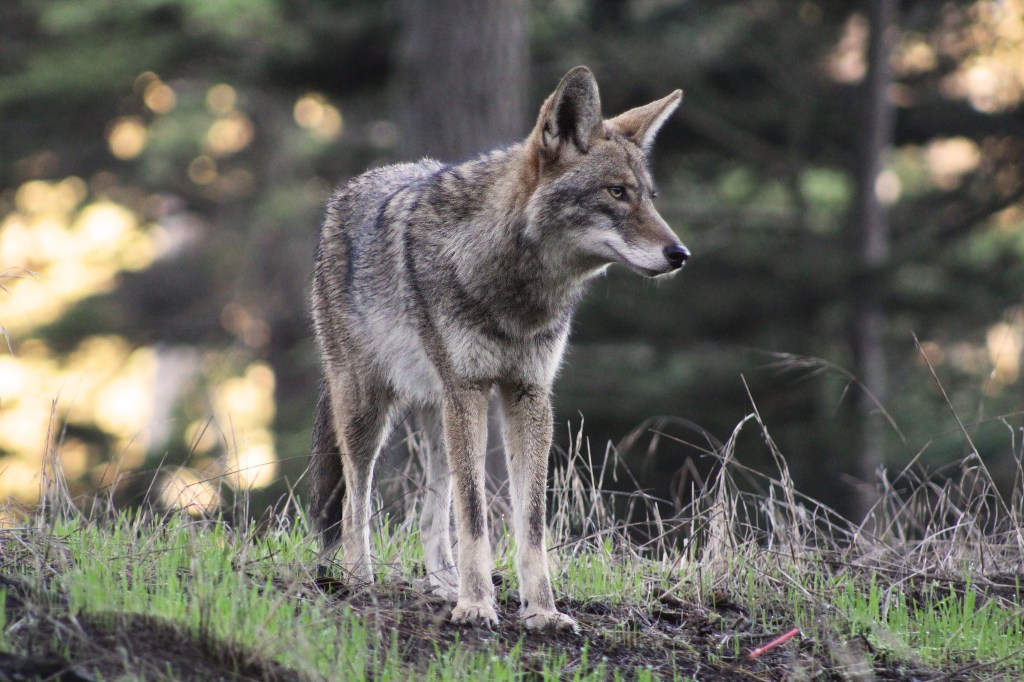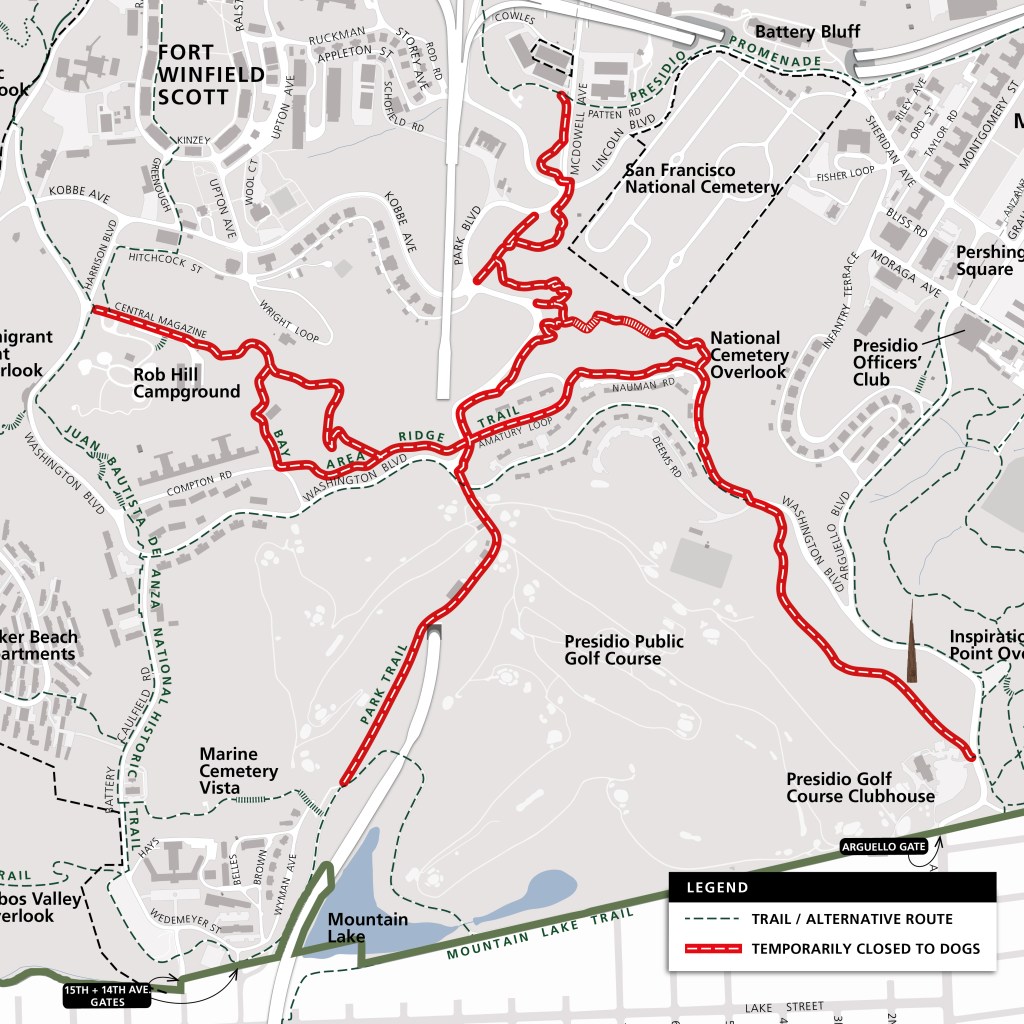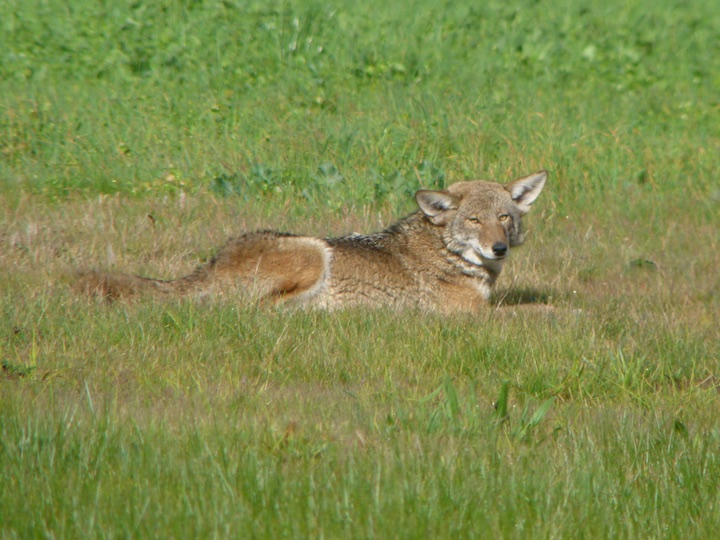Coyotes in the Presidio
Learn how we manage coyotes and support the co-existence of people and wildlife.
The Presidio is a national park site. Making it welcoming and safe for people and protecting wild plants and animals are core parts of our mission.
Coyotes are part of the Presidio’s natural ecosystem. They play an important role in the park’s environment by keeping rodents and raccoons at healthy levels.
Because the Presidio welcomes millions of visitors and is a place where people live and work, the Presidio Trust has an active coyote management program that includes public education. Our goal is to reduce conflicts between coyotes, dogs, and people.
We work regularly with other Bay Area agencies to develop strategies to assess wildlife behavior and determine appropriate responses. Our management actions range from public education on deterrents/hazing to ensure the animal retains its fear of humans to – under very rare circumstances – lethal removal of a coyote evaluated and determined to be a threat to public safety.
This page offers guidance on how to enjoy the Presidio in harmony with wildlife.

Report any incidents of concern (such as aggressive coyote behavior or visitors feeding a coyote) to the Presidio Trust Work Order Service Center.
Dogs and Coyotes
The Presidio is unique among national park sites in that most spaces are available for dog walking. Learn more in the Dogs in the Presidio section.
Coyotes are canines and may act aggressively towards dogs because they view them as territorial competitors or as potential prey.
Coyotes may also be protective of their young during pupping season, which runs from spring to fall. To reduce the potential for coyote/dog conflict, we proactively close large sections of the Park Trail and the Bay Area Ridge Trail to dog walking from April to October. Dog walking trail closures are currently in effect.

Aggression towards a dog is considered normal coyote behavior and does not necessarily mean that a coyote will be aggressive towards a person.
One of the most important things you can do to avoid a coyote interaction is keeping your dog on leash. Dogs are required to be on leash in the Presidio, except for a designated managed voice control area on West Pacific Avenue. Learn more in the Dogs in the Presidio section.
How to Deter Coyotes in the Presidio
Have you ever wondered what to do if you’re on a park trail and you encounter a coyote? Presidio Trust Wildlife Ecologist Phoebe Parker-Shames shares all you need to know to co-exist responsibly and effectively with coyotes living in the Presidio.
If You Encounter a Coyote in the Presidio
- Keep your distance; do not approach the coyote unless you are actively deterring/hazing it
- Keep your dog on a leash and under your control
- Observe posted signs about coyote activity in the park
- Supervise children when outdoors
- Never attempt to feed a coyote
If you encounter a coyote within 50 feet and the coyote does not move away on its own, here are ways you can deter or intimidate the animal to help it maintain a safe distance (see video for demonstrations):
- Maintain eye contact, which makes them uncomfortable and timid
- Be as big and loud as possible; shout in a deep, loud, and aggressive voice
- Wave your arms, use a tool like an umbrella, and throw small objects (to scare, not injure)
If the coyote continues to approach, do not run or turn your back on the coyote, but continue to exaggerate the above gestures while backing away slowly. Be aware that deterrents may not be effective if you have a dog with you or if there are coyote pups nearby. Report this type of incident to the Presidio Work Order Service Desk at (415) 561-4270 or coyote@presidiotrust.gov.

About Coyotes in the Presidio
There is one alpha coyote pair in the Presidio. Within a claimed territory, only one pair of coyotes will breed. This bonded male and female are long-term residents of the territory and known as the alpha pair. They patrol their territory to keep non-resident coyotes out. The alpha pair remain bonded for life.
Coyote pupping season runs spring to fall, when there is more potential for dog/coyote interactions as coyotes protect their young.
Typically, year-old pups are driven from the parents’ territory, and the resident population – the alpha pair – remains stable. That said, it’s difficult to know how many coyotes are in the Presidio at any given time.
As of July 2024, there’s a breeding pair, an unknown number of this year’s small pups, and possibly two full-grown year-old pups from last year that are in the process of dispersing.
Help Us Monitor Coyotes
Most of the time, when you see a coyote in the Presidio it will simply be minding its own business, for example hunting wild prey or resting. In these situations, it’s not necessary to send in a conflict report, but we’d still love to hear about what you saw! You can submit a photo of the sighting via iNaturalist through their app or website. Please report any identifying characteristics.
VIDEO: Coyotes in the Presidio
Frequently Asked Questions
Contact the Presidio Trust Work Order Service Center at (415) 561-4270 or coyote@presidiotrust.gov.
The Presidio Trust’s goals are to ensure public safety, minimize encounters, and keep resident coyotes wild. To achieve these goals, we promote community education in addition to applying the most current scientific understanding of coyotes. Careful coyote monitoring helps us understand the Presidio’s coyote population and ensure human safety.
Coyotes are adaptable and often live in or near urban areas. They are seen throughout San Francisco and live in most large city parks. The Presidio offers good habitat for coyotes due to its wild food sources, water sources, and green open space. Coyotes feed primarily on rodents and play a valuable role in the Presidio’s ecosystem, primarily through natural pest control.
Coyotes were historically found in the Bay Area due to the abundance of habitat, food, and water. As San Francisco grew, coyotes were pushed out. The last coyote recorded in the city in the 20th century was seen in 1925 in Golden Gate Park. In addition to loss of habitat due to urban expansion, coyotes were historically not socially tolerated and were hunted for recreation and/or control. Coyotes began to return to the Presidio in 2002 and are also seen in other parks around San Francisco.
Coyotes have:
- Large erect ears, narrow muzzles, and golden brown eyes
- Bushy tails held down when the animal is in motion
- Reddish-yellow, tan, brown, or grey coloring
- Bib-like patch of white fur around lower jaw and neck
- Darker grey and black hairs on upper body and lighter cream-colored undersides
- Between 20-40 pounds, but often appear heavier in winter due to a thick double coat of fur. In the summer, they shed their thick coats and can appear lean or “scrawny.”
Coyotes are timid animals with a natural fear of humans. Although they tend to be most active in the evenings and early mornings, they can be active throughout the day.
Due to a lack of large predators, urban coyotes have not learned to view humans as hunting predators. However, when humans “haze” or act aggressively (yelling, eye contact, throwing objects, etc.), they will likely retreat. Even in nonaggressive encounters, regular hazing is encouraged.
Coyote pupping season typically runs from March through September. Coyotes mate in mid-February and are ready to give birth by mid-April. During this time, both when nearing birthing time and once the pups are born, coyote parents are more protective of their denning areas and more active in hunting food. Their level of activity and protectiveness rises even as the pups begin to venture out of the den in early summer.
In the unlikely event that a coyote approaches you (or if you have an encounter within 50 feet and the coyote does not move away on its own accord) do the following:
- Be as big and loud as possible; shout in a deep, loud, and aggressive voice
- Wave your arms and throw small objects (to scare, not injure)
- Maintain eye contact (which makes them uncomfortable and timid)
- If the coyote continues to approach, do not run or turn your back on the coyote but continue to exaggerate the above gestures
Pupping season (spring to fall) is when dog walkers should stay aware of their surroundings. Coyotes are members of the canine family and can be reactive to the presence of dogs. They may exhibit den protective behaviors and guard a localized area from other canines that are regarded as outsiders attempting to kill the pups. These protective behaviors are always focused on canines. We typically close sections of trails near a den area to dog walking during pupping season.
Always have your dog on leash. In the event of an encounter, be calm, initiate the hazing actions listed above, and leave the area. Coyote aggressiveness is meant to frighten other canines away from the den. This protective behavior can sometimes override their response to hazing techniques, and they may not retreat. In this case, calmly and quickly (do not run) leaving the area will usually terminate this aggressive response. If the coyote follows, continue to walk away from the denning area.
None of the coyotes in the Presidio have exhibited the type of abnormal behavior associated with rabies. Behaviors such as the animal appearing excessively drunk or wobbly, circling, seeming partially paralyzed, acting disorientated, or mutilating itself may be signs of disease.
Coyotes are abundant throughout the Bay Area. Where there is suitable habitat (e.g. Golden Gate Park, Presidio, Twin Peaks, McLaren Park, Lake Merced, etc.) coyotes will and have colonized. If a coyote is removed from its local territory, another will quickly take its place. In other words, there is an endless supply surrounding the greater Bay Area. Coyotes came back to San Francisco on their own and will continue to thrive here in today’s urban environment.
Coyotes have hierarchical social behavior which limits their populations. Territories are established and defended from other coyotes by an alpha pair. Urban territories are smaller due to resource availability and fragmented habitat as a result of roads, buildings, and other physical barriers. When pups are old enough, parents run them out of the territory. Pups disperse to establish territory that is not claimed. The Presidio, 2.3 square miles, has resources to support two breeding pairs (USGS, Erin Boydston, Research Ecologist).
No. Studies have shown that most translocated individuals will attempt to travel back to their home territory, and most die in the process or create more conflict in the area where they are introduced. The only way to effectively and ethically remove a coyote is with lethal removal.